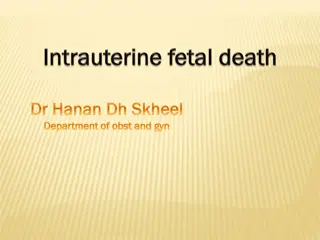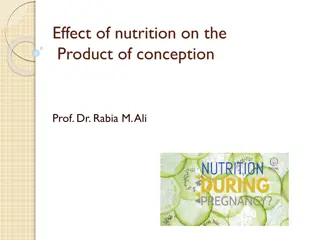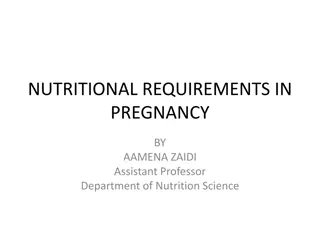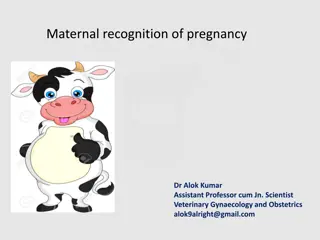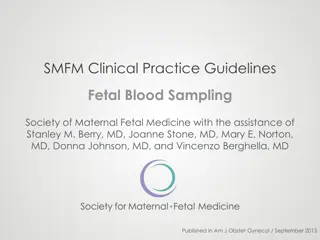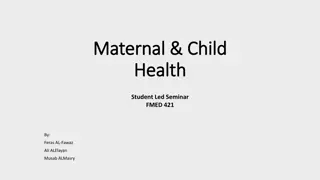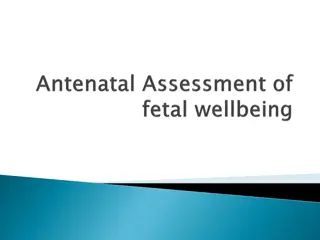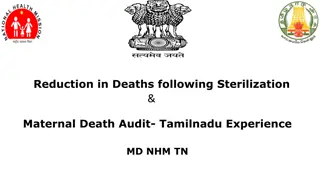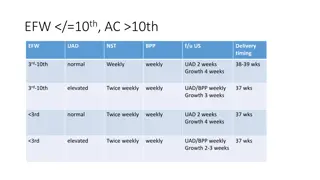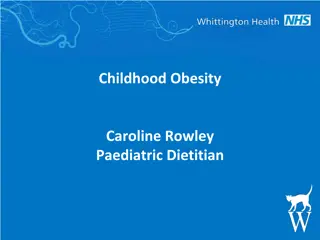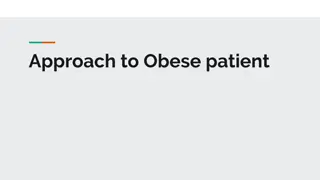Maternal and Fetal Complications of Obesity in Pregnancy
Understanding the impact of obesity stigma as a stressor throughout the lifecourse is essential, especially concerning pregnancy. The prevalence of pre-pregnancy overweight and obesity poses significant risks, leading to various maternal complications like gestational diabetes, cesarean delivery, and postpartum hemorrhage. Additionally, fetal complications such as congenital anomalies and fetal distress are crucial considerations in managing obesity during pregnancy. Effective interventions can help mitigate some risks, but ongoing research is needed to enhance postnatal outcomes and promote healthier pregnancies.
Uploaded on Jul 13, 2024 | 2 Views
Download Presentation

Please find below an Image/Link to download the presentation.
The content on the website is provided AS IS for your information and personal use only. It may not be sold, licensed, or shared on other websites without obtaining consent from the author.If you encounter any issues during the download, it is possible that the publisher has removed the file from their server.
You are allowed to download the files provided on this website for personal or commercial use, subject to the condition that they are used lawfully. All files are the property of their respective owners.
The content on the website is provided AS IS for your information and personal use only. It may not be sold, licensed, or shared on other websites without obtaining consent from the author.
E N D
Presentation Transcript
UNDERSTANDING OBESITY STIGMA AS A STRESSOR ACROSS THE LIFECOURSE SHARON BERNECKI DEJOY, PHD, MPH, CPH, CPM WEST CHESTER UNIVERSITY OF PENNSYLVANIA
ACKNOWLEDGMENTS With thanks to: UConn Rudd Center for Food Policy and Obesity Janell Mensinger, PhD Drexel University College of Nursing and Health Professions Emily Holladay West Chester University of Pennsylvania BS Public Health-Health Promotion student Debra Mandel, PhD, RNC-OB West Chester University of Pennsylvania College of Health Sciences Krystle Bittner, MPH
EPIDEMIOLOGY Prevalence of pre-pregnancy overweight in women: 24.9% Prevalence of pre-pregnancy obesity: 22.1% 2009 PRAMS data (Robbins et al., 2014)
MATERNAL COMPLICATIONS OF OBESITY Miscarriage Cesarean delivery Hypertensive disorders Wound infection Gestational Diabetes Mellitus (GDM) Postpartum hemorrhage Preterm Birth Anesthetic complications Assisted Vaginal Delivery Increased length of stay in hospital Stillbirth Galliano & Bellver, 2013
FETAL COMPLICATIONS Congenital Anomalies Fetal Distress Macrosomy Hydramnios Shoulder Dystocia Hypoglycemia Jaundice Galliano & Bellver, 2013
POSTNATAL COMPLICATIONS Obesity Type 2 Diabetes Cancer Neurodevelopmental delay Galliano & Bellver, 2013
EFFECTIVENESS OF INTERVENTIONS IN PREGNANCY Behavioral interventions reduced gestational weight gain by 3.6 pounds, on average, among women with obesity, but not among overweight or severely obese women. These interventions had no effect on length of gestation or infant birth weight, and did not affect the woman s postpartum weight status in any weight category. Postpartum/interconceptional weight loss is possible, but best practices are emerging. Agha, Agha & Sandell, 2014; Nascimento et al., 2014; van der Pligt et al, 2013
EFFECTIVENESS OF WEIGHT LOSS INTERVENTIONS IN GENERAL Weight loss of 5% to 10% = success Only 10-20% can maintain a 10% a weight loss after 1 year 10% loss is typical outcome of the best behavioral and/or pharmacological treatments Significant weight loss is not readily sustainable with current conventional treatment options Wadden & Foster, 2000; Wing & Hill, 2001
MATERNAL OBESITY IS A PUBLIC HEALTH PROBLEM. WHY IS IT ADDRESSED THROUGH LESS-THAN-EFFECTIVE INDIVIDUAL-LEVEL INTERVENTIONS?
THEORETICAL FRAMEWORKS IN MCH LIFECOURSE FRAMEWORK, SOCIAL ECOLOGICAL MODEL, AND MULTIPLE DETERMINANTS
LIFE COURSE PERSPECTIVE-KEY CONCEPTS Today s experiences and exposures influence tomorrow s health. (Timeline) Health trajectories are particularly affected during critical or sensitive periods. (Timing) The broader community environment biologic, physical, and social strongly affects the capacity to be healthy. (Environment) While genetic make-up offers both protective and risk factors for disease conditions, inequality in health reflects more than genetics and personal choice. (Equity) U.S. Department of Health and Human Services, 2010, p. 4
SOCIAL ECOLOGICAL MODEL Source: CDC
Figure 1 Womens reproductive cycles. Source: Misra, Guyer & Allston, (2003)
SOCIAL DETERMINANT: RACISM Consistent associations between perceptions of racial discrimination and preterm birth, low birth weight, and very low birth weight in African-American women. (Earnshaw et al., 2013; Giurgescu, McFarlin, Lomax, Craddock, & Albrecht, 2011) Structural racism places African-American populations at elevated risk for social and economic disadvantage. (Mendez, Hogan, & Culhane, 2014). Interpersonal racism in daily life and health care encounters can provoke psychosocial distress. (Williams, Yu, Jackson, & Anderson, 1997)
WHAT IS STIGMA? Convergence of 5 processes Labeling of human differences occurs 1. Individual is linked to undesirable characteristics (stereotyped) 2. Separation of stigmatized others ( us versus them ) 3. Discrimination and loss of status occurs 4. Power differences 5. Link & Phelan, 2001
Source: Puhl, R.M. (2013) Clinical Implications of Obesity. Presentation, Rudd Center for Food Policy and Obesity. 19
OBESITY STIGMA : A WIDESPREAD PROBLEM Research shows overt weight-based discrimination has increased among children and adults Children report weight as most common reason for bullying One study showed that 92.5% of undergraduate sample endorsed fat stigma Family members followed by physicians are most common source of weight stigmatization Ambwani et al, 2014; Andreyeva, et al., 2008. Puhl &Brownell, 2006; Puhl et al., 2011
WEIGHT STIGMA IN EMPLOYMENT People with a higher BMI are Less likely to be interviewed Less likely to be hired Earn less Fewer promotions Employers rate larger people as Less competent, lazy, sloppy, disagreeable, emotionally unstable Puhl & Peterson, 2014
WEIGHT STIGMA IN EDUCATION Children with a higher BMI perform poorer academically Research shows weight-based teasing may play a mediating role Children report missing school due to weight-based victimization Teachers have lower expectations of children with a high BMI Larger sized children are characterized by teachers as: Untidy Emotional Less likely to succeed at work More like to have family problems Krukowski, et al., 2009; Neumark-Sztainer, Story, & Harris, 1999; Puhl, Luedicke, & Heuer, 2011
WEIGHT BIAS IS PREVALENT ACROSS PROFESSIONAL GROUPS Studies documented weight bias in: Physicians Nurses Medical students Psychologists Dietitians Fitness professionals Puhl & Brownell, 2001; Puhl & Heuer, 2009
PERCEPTIONS OF CLIENTS WITH OBESITY Providers view obese patients as Non compliant Lazy Awkward Weak-willed Dishonest Unsuccessful Unintelligent Ferrante et al., 2009; Campbell et al., 2000; Fogelman et al., 2002; Foster, 2003; Hebl & Xu, 2001; Puhl & Heuer, 2009; Huizinga et al., 2010
WEIGHT BIAS Physicians report As patient BMI increases, physicians report: having less patience less desire to help the patient seeing obese patients was a waste of their time having less respect for patients Hebl & Xu, 2001; Huizinga et al., 2009
WEIGHT BIAS Nurses report: 31% would prefer not to care for obese patients 12% would prefer not to touch obese patients 24% agreed that obese patients repulsed them Poon & Tarrant, 2009; Brown, 2006; Bagley, 1989; Hoppe & Ogden, 1997; Maroney & Golub, 1992
PATIENT REACTIONS Feel berated & disrespected by providers Report that their weight is blamed for all problems Upset by comments about their weight from doctors Reluctant to address weight concerns Perceive that they will not be taken seriously Anderson & Wadden, 2004; Bertakis & Azari, 2005; Brown et al., 2006; Edmunds, 2005
IS CARE AFFECTED? Provider interactions with obese patients Less time spent in appointments Less discussion with patients More assignment of negative symptoms Less intervention Bacquier et al., 2005; Bertakis & Azari, 2005; Campbell et al., 2000; Galuska et al., 1999; Hebl & Xu, 2001; Kristeller & Hoerr,1997
IMPACT ON CARE Patients with obesity are less likely to obtain Preventive health services & exams Cancer screens, pelvic exams, mammograms and are more likely to Cancel appointments Delay appointments and preventive care service Adams et al., 1993; Aldrich & Hackley, 2010; Drury & Louis, 2002; Fontaine et al., 1998; Olson et al., 1994, Ostbye et al., 2005; Wee et al., 2000
AVOIDANCE OF CARE Study of 498 women: Obese women delayed preventive services despite high access Women attributed their decisions to: Disrespect from providers Embarrassment of being weighed Negative provider attitudes Medical equipment too small *Barriers increased with BMI Amy et al. (2006)
HOW STIGMA GETS UNDER THE SKIN WHAT ARE THE HEALTH CONSEQUENCES OF ALL THIS? 32
ALLOSTATIC LOAD Multi-disciplinary, framework for studying the relationship between stress and disease Operationalized as a index of physiological dysregulation involving multiple organ systems Captures how our body copes with threatening or unpredictable environmental stimuli Is the consequence of regulatory wear and tear on the body and brain that leads to illness 33 McEwen, B. S., & Stellar, E. (1993).
ALLOSTATIC LOAD Chemical messengers released in brain in response to stress Chronic or frequent demands for these messengers can lead to insufficient, non-habituating, or prolonged production Metabolic, inflammatory, and cardiovascular systems all become dysregulated
35 Beckie, (2012)
PERCEIVED DISCRIMINATION AND HEALTH 2009 Meta-analysis shows very robust associations Data from 110 studies examining mental health Symptoms of depression, anxiety, PTSD, psychosis, paranoia, psychological distress, general well- being, life satisfaction, self-esteem, perceived stress, anger, etc.) Data from 36 studies examining physical health Outcomes included BP, plaque, heart rate variability, CVD, pelvic inflammatory disease, yeast infections, respiratory conditions, etc. 36 Pascoe & Smart Richman, (2009)
WEIGHT STIGMA AND MENTAL HEALTH Depression Anxiety Disordered eating Self-esteem Exercise Avoidance 37 Durso et al., (2012); Greenleaf, Petrie, & Martin, (2014); Hilbert, Braehler, Haeuser, & Zenger,(2014)
WEIGHT/PHYSICAL APPEARANCE DISCRIMINATION AND AMBULATORY BP Sample of 207 Black and White adolescents Rating physical appearance/weight as being the primary reason for being discriminated against was a predictor of higher ambulatory blood pressure after controlling for BMI, race, sex, physical activity Race was also a predictor of BP 38 Matthews, Salomon, Kenyon, & Zhou (2005)
PERCEIVED WEIGHT STIGMA AND HPA ACTIVATION Weight stigma frequency and stress hormones measured in 45 women with high BMI Models controlled for abdominal adiposity, perceived stress, age, income, education Significant associations between weight stigma and stress hormones regardless of weight status 39 Tomiyama, Epel, McClatchey, et al. (2014)
HEALTH CONSEQUENCES Maladaptive eating behaviors Binge eating, unhealthy weight control practices, comping with stigma my eating more food Study: Survey of 2,449 women How do they cope with stigma experiences? 79% reported eating; turning to food as coping mechanism Haines, et al., 2006; Neumark-Sztainer et al., 2002; Puhl & Brownell, 2006, Puhl et al., 2007; Puhl & Luedicke, 2011
HEALTH CONSEQUENCES Internalizing Weight Stigma Study: 1013 women (national non-profit weight loss support organization) Women who internalized experiences of weight stigma and blamed themselves engaged in more frequent binge eating (even after accounting for self-esteem, depression, and amount of stigma experienced) Puhl, Moss-Racusin, Schwartz, (2007)
BEHAVIORAL CONSEQUENCES OF OBESITY STIGMA Higher calorie intake Higher program attrition Less weight loss Avoidance of physical activity Lower motivation for exercise Bauer et al., 2004; Faith et al, 2002; Matthews et al., 2005; Schwimmer et al., 2003, Storch et al., 2006; Schmaltz, 2010; Seacat & Mickelson 2009; Vartanian & Shaprow, 2008; Vartanian & Novak, 2011
IN SUMDOES A HIGH BMI OR THE STRESS OF BEING STIGMATIZED FOR IT CAUSE DISEASE? Source: Puhl & Heuer, (2010)
OBESITY STIGMA IN PREGNANCY UPSTREAM AND DOWNSTREAM DETERMINANT OF POOR BIRTH OUTCOMES?
Social Root Causes Determinants
STUDIES OF WEIGHT STIGMA AND PREGNANCY Little research conducted on chronic or recent obesity stigma experienced by pregnant women with a high BMI Given the rates of obesity stigma and associated pregnancy complications in the U.S. it is critical to examine this issue DeJoy & Bittner (2015)
SIZE-ISM AS STRUCTURAL DISADVANTAGE/DOWNSTREAM INFLUENCE Intersection of weight and gender discrimination is major source of inequity in the US. (Mason, 2012). Overweight and obese individuals are at increased risk of employer discrimination. (Puhl & Heuer, 2011; Puhl, Heuer, & Brownell, 2010) Obese women tend to have lower levels of educational attainment and income and a lower marriage rate than their thinner peers. (Puhl & Heuer, 2010)
INTERNATIONAL STUDIES OF WEIGHT STIGMA AND PREGNANCY From Scandinavia, Australia and the UK Depersonalization Medicalization Lack of respect Smith & Lavender(2011)
U.S. STUDY ON EXPERIENCES OF WEIGHT STIGMA IN MATERNITY CARE DeJoy, Bittner, & Mandel (2015).




